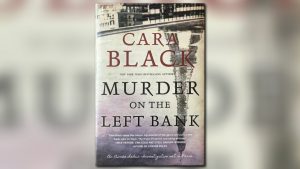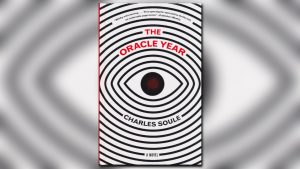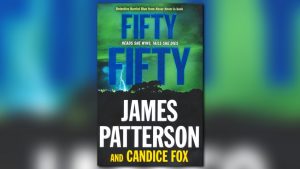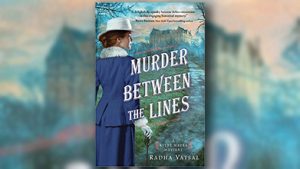Robert M. Edsel’s “The Monuments Men” follows six Monuments Men and their mission to save the world’s greatest art from the Nazis.
The Monuments Men were a group of men and women from thirteen nations who had expertise as curators, artists, museum directors, art scholars and architects.
They volunteered for service in the Monuments, Fine Arts and Archives section, which was mandated by President Roosevelt and supported by General Eisenhower, with the goal to save as much of European culture as they could during combat.
In a race against time each man gathered scraps and hints to construct his own treasure map using records recovered from bombed cathedrals and museums, the secret notes and journals of Rose Valland, a French museum employee who secretly tracked Nazi plunder through the rail yards of Paris and even a tip from a dentist during a root canal.
VOICEOVER: And now an Eight original production.
VOICEOVER: Books & Co. is made possible by the Virginia G. Piper Center for Creative Writing, searching writers and readers in the Phoenix metropolitan area, the state of Arizona, and the world.
ALBERTO RIOS: Welcome to Books & Co. Bienvenidos todos. I'm your host Alberto Rios. We're joined by Robert Edsel, who will be talking about his book, "The Monuments Men." Welcome, Robert.
ROBERT EDSEL: Thank you, Alberto. Great to be here. Thank you.
ALBERTO RIOS: That’s hard to say, "The Monuments Men." We were having a talk about that before the show started. I would like to pick up on that. What about a title that's just slightly hard to say, before we go into the book?
ROBERT EDSEL: I think there's a benefit to it because from my perspective this is the second book I have written and expectation to write more. In fact I have written a third book called Saving Italy, but Monuments Men is in the sub title. People don't know the story and don't know that phrase. I think there's a benefit to putting something out there albeit it creates a difficulty for the author and publishing house on the front end but it causes a curiosity, particularly about World War II, which people know so much about, the fact that they haven't heard about this causes them to pause for a minute.
ALBERTO RIOS: I'm going to call it a linguistic trick but I don't mean that in a denigrating way. It makes us take notice of something we didn't know there was something to take notice about. That's what the book is about. Give us a slight preview of this. This is about World War II.
ROBERT EDSEL: It is, but it's a huge story we don't know about. Amazing that there could be a major story we don't know about. Describing how I learned about it is the best way of describing the book. Walking in Florence, the only bridge not destroyed by the Nazi when they fled the city in 1944. I wonder how did so many of these works of art and cultural treasures, monuments how were they saved. I was hugely embarrassed, it never occurred to me to ask what is seemingly can be obvious question. We know there was so much devastation in the European cities and in the countryside. Yet we go to museums and churches today and everything is back where it was. It had to be somewhere else. It seemed extraordinary to me there wasn't an easy answer somewhere. It led me down this path I couldn't possibly have foreseen, the work of the Monuments Men Foundation. It's been such a fascinating subject to write about these men and women, average age in their 40s, most had established careers, many had families, some had kids, and they had ever reason not to volunteer to go into combat to be a new kind of soldier, but they felt they had an important role.
ALBERTO RIOS: It's funny, in all the news footage we see, all the ways we perhaps remember how World War II was represented it's all about destruction.
ROBERT EDSEL: It is.
ALBERTO RIOS: About the neon of the loud.
ROBERT EDSEL: It is.
ALBERTO RIOS: Whether it's Hitler up there or Churchill responding, whatever, this is the quiet and elegantly human part of something. This is something about us as human beings that this also mattered perhaps ultimately and we would like to think it mattered more than the other things we were seeing.
ROBERT EDSEL: It's an uplifting story about World War II.
ALBERTO RIOS: That by itself is an interesting phrase.
ROBERT EDSEL: Hard to imagine. Obviously the backdrop is quite horrific. This is how the Holocaust begins, not with destruction of lives but with the theft of cultural objects that defined who those people are. Incarnating people, putting them in concentration camps, but leaving them alive to witness this humiliation of seeing everything that defines them as a people destroyed or stolen, yes, they are going to be killed in the end, but it begins with stripping them of rights, changing the laws and in that part it's particularly horrific and permission. This premeditated planning on the part of Hitler unlike any war we have seen before and the means and method of transporting these works of art, volumes Napoleon could only dream of. The idea that president Roosevelt would endorse such a concept, that General Eisenhower would issue historic orders that place responsibility on all commanders to fight a war and yet mitigate damage to cultural treasures and place responsibility on commanders to do all they could to protect cultural treasures is a completely new way of having fought a war and it set a high bar for cultural treasures. Our country and no other has attained since World War II.
ALBERTO RIOS: If we were to place it in a contemporary context it's like rescue platoon of the nerds. It has that --
ROBERT EDSEL: Red Cross for the protections of works of art if you want to think of it that way.
ALBERTO RIOS: Which is again a satisfying notion that not everybody had to have a rifle to fight this war. This group, they were really conservators. They came in later in the progress of the war. I don't know who finally -- where the light bulb went off. You do a great job of parsing this through, but who finally decided, yes, where was the magic switch?
ROBERT EDSEL: Well, the fascinating thing about the telling of "The Monuments Men" story, and I have done the same in Saving Italy, which tells what took place in Italy, it's a people story. We talk about things, objects which are important because they define us as a civilization, but it was the people I was interested in, the good guys rather than the bad guys. Why would these middle aged museum professors and art historians and artists walk away from their lives go do this? What in the world were they thinking? The idea was really the origination of this art conservator George Stout, who was old enough he fought in World War I the last year and he was convinced there would be a Second World War. He believed the new technology of bombing and the fires they caused presented a threat to cultural treasuring unlike anything we had ever seen before. It would be the ghost of history forever. He came up with this idea, floated it, and eventually it was his idea more than any other, there were others that also had similar ideas, that made it to president Roosevelt's desk. He thought smart idea to me. It ultimately makes its way to General Eisenhower, who empowers these men and women to do it. They were behind the 8-ball in the beginning. There’s no Monuments officer there at the beginning. An Army of one arrives in late July 1943, and for five months it's a mess as an operation which leads General Eisenhower to issue an historic direction saying it's the responsibility of commanders to protect cultural treasures during war. Eisenhower didn't think that was necessary. He felt like they have a job to do, everyone will pay attention to it, but nobody would because the supreme allied commander hadn't said it was a priority. That really changes the face of war. Two weeks before the Normandy landing he reissued the same order but this time two weeks before, not six months after the invasion.
ALBERTO RIOS: So something was learned.
ALBERTO RIOS: The irony of course is that it was an American idea. America, the newest country, not the creator of those monuments, those treasures. Deciding they were going to help save them.
ROBERT EDSEL: That's true. It's an American and British led operation. The British were contacted about this early on and Kenneth Clark, the great scholar and director of the national gallery of London, said, great idea, it will never work. He didn't believe if you had men and women running around with Army units, individuals advising Army commanders about what they can and can't shoot at it would never work. Turned out he was wrong. "The Monuments Men" doubted it would work but felt it was a fight we needed to make an effort to do. The idea that Americans would have these ideas really if you dig deeper isn't as surprising as it seems in this context. Most of these men and women had been educated; many of them had been in Europe educated between the wars. Some had been in Europe for World War I. They knew these countries, most spoke second or third languages. They had this sense of obligation to do what they felt they could do. They weren't soldiers to go shoot at the enemy, but they had a role to help win the freedom and felt it was their responsibility -- what was the point of running museums and doing the jobs they were doing if everything was destroyed during World War II?
ALBERTO RIOS: As we read through the book it so easily could have been and so nearly was and the record of these men coming up at first they are assessing damage. As I was reading it, it's not a way of saving all of it, let's do what we can.
ROBERT EDSEL: That's a perceptive observation.
ALBERTO RIOS: Then it becomes active.
ROBERT EDSEL: Yes, a perceptive observation. What gets the glamour of their job, the attention is the art detective work. At the beginning they don't know the degree of theft that's taken place. It begins with art preservation work trying to advise military commanders and in particular air commanders where no the to bomb, where to avoid accidents there was a near destruction of the last supper in Milan, a British bomb landed some 88 feet away. Obliterates the east wall of the refectory. It's a miracle that that survived. These are the things Monuments officers are doing. Once they have boots on the ground in Sicily, in Naples, again in northern Europe, their job shifts to effecting temporary repairs as a way not only of defeating the Nazi propaganda but also winning over the people. Eisenhower understood you have to show respect for the things that they value and you do that by repairing so many of the things that were destroyed by allied bombing or allied artillery so we could get soldiers on the ground. But by the time they get through the western European countries into Aachen, the first conquered German city, the destruction is so severe there's not much preservation work and it shifted to art detective work trying to find some of the millions of cultural objects stolen by the Nazis.
ALBERTO RIOS: While they are trying to do, that that's their primary goal, one of my favorite parts of the book was the brilliant idea of first educating the soldiers who were there. We forget, these are young kids. They are just going in. They have rifles, they got bombs. They're mad at the Germans. Everybody is mad. It's all about destruction. The brilliant stroke is to educate the occupying forces about the history that's bigger than Adolph Hitler.
ROBERT EDSEL: Right. Many of these guys were college professors. One of the key Monuments officers in Saving Italy in my last book is a professor named Dean Keller, professor of art at Yale. He's 42 years old. He's watched his class sigh dwindle down to just two boys as he refers to them. College was reduced down to two years and seven months. It wasn't a four-year program because they cut out the summer sessions because of the emergencies going on. But between boys being drafted, volunteering, there wasn't anybody left in the classroom to teach any more. So these guys were uniquely qualified to work with not only with soldiers about educating about what they are looking at but in particular persuade their superior officers who oftentimes were half their age about why if there's a sniper in a church, don't aim a tank round at the center of the church to take down the entire church. If a building of historical importance has been damaged, many who were architects could tell, it could be repaired, don't knock it over for the materials. They didn't have the command authority to order officers to do this, they to persuade them. In the significant positions they had before, running museums and other cultural institutions with no resources they knew they were resourceful. They adapted, overcame shortcomings and were very persuasive. And they did it through educating.
ALBERTO RIOS: That was a stunning perception on their part that there was a better way to do this in the midst of what seemed like only one way. Let's bowl right through it. I'm going to take a moment to remind our viewers you're watching Books & Co. I'm your host Alberto Rios. We're joined by Robert Edsel, talking about his latest book, "The Monuments Men." I want to -- I brought something with me. I'm going to hold this artifact up. This follows me every day. It's a key chain. It says, Tapestry of Bayeux. It's got a little -- on this side. In the '80s, mid '80s, I went to France and saw this tapestry. It's one of my favorite cultural artifacts anywhere but I didn't know the story.
ROBERT EDSEL: It's a remarkable story, prototypical typical of so many other iconic not just works of art but cultural treasures which Hitler was determined to have. Sometimes out of their beauty, oftentimes out of the sense of power of having control of these objects conferred. The Bayeux Tapestry is something that has origins back to the 14th century. It is fairly narrow in width, about a foot and a half, two feet, but it's many, many yards wide. In it, it tells through this tapestry about the wars between France and England at this point in time, no one knows exactly who the creator of it is, but it's a hugely important document, if you will, historical document about the events of Europe during the time. Hitler, you figure, this happens so many times, where human nature would argue if the enemy is down the road a day or a week, you would run for the hills to save your life and get out of there. Not the Nazis. In this instance the American Army is about to liberate Paris. It's August 1944. Several Nazi SS officers show up to the German commanding general in Paris and tell them they are there on orders from him letter to confiscate the Bayeux Tapestry and take it back to Berlin. They stand on the balcony of Von Schultheis's office where bullets are pinging by. They know they are not going to hold Paris. Von Schultheis is astonished and he points to the Louvre where the tapestry has been placed for safekeeping and says it's over there. They say, but we need some help. He looked at them and said, surely two officers of the S.S. aren't afraid to go there. They left and they didn't get it, but one example of something they did get, the great Bruges Madonna by Michelangelo, the only sculpture to leave Italy in his lifetime, which was at the church in Bruges. In September with the British Army just a week down the road, knowing they are not going to hold Bruges, some German soldiers come in dressed in Red Cross uniforms and in the dead of night steal the sculpture along with a number of paintings, load them up in the truck and take them in the dead of night because they had orders to do it, September of 1944. These are counterintuitive to what human nature is, yet orders were orders and it was never too late to get the last things.
ALBERTO RIOS: The Nazis appropriating this work and spiriting it away may have saved it.
ROBERT EDSEL: No question. It's one of the many paradoxes of the war. One photo I use oftentimes is this American rabbi chaplain standing on a pile of Torahs some ten feet high, a thousand Torahs trying to see what synagogue they came. From you figure that's the first thing the Nazis would have destroyed but this is part of their effort to create racial institutes where they would show Germans people how Jews were sub human and as a result saved many of these things. And then of course did not have a change to destroy them before the war was over. You're absolutely right. I refer to it sometimes tongue in cheek as Nazi logic. It doesn't make sense any other time in history other than the period that the Nazis were in control. You're correct, some of the things that survived did so because they were stolen and hidden in salt mines where the bombs -- where they were impregnable to bombing, in this case allied bombing.
ALBERTO RIOS: And on top of that, they were just assiduously keeping notes. That was so striking to me that like libraries. Almost more documented.
ROBERT EDSEL: Well, that's right. In fact on the front cover photo of Monuments Men you see one of the key officers standing on the steps of the castle of Liechtenstein, everyone has seen it in Disney films, Sleeping Beauty, fairy tale castle, one of some 1800 hiding places in salt mines, caves and castles the Nazis hid works of art. He knows to go through because of the extraordinary relationship he developed with Rose Valland one of the great heroines of World War II. They have been so great to go to all the World War II movies with us guys, this is your film. This is your book. Rose Valland. You have a woman heroine, who is an extraordinary woman that works under the nose of the Nazis for four years without them knowing she speaks German or understands it. And assembles all these secret records. They find 21,000 stolen works of art, sculpture, furniture along with so many documents the Nazis had evidencing the theft, used during the trials at Nuremberg.
ALBERTO RIOS: Stunning. This may have been casual language, but you refer to three people as being indispensable in this book. Rose Valland is one. I think George Stout is the other, Adolph Hitler is the other. It's that word that stood out for me, indispensable. You talk about him in different instances but they become, oddly enough, the players, though George and Rose would have met each other but they would not have met each other.
ROBERT EDSEL: Rose watched Hermann Goering make 20 separate shopping expeditions. We can't call them anything else but that, to this small museum she was in charge of that became Nazi central headquarters for the loot brought in, processed, photographed. She was making secret notes about this over four years. If they had ever caught her, they would have killed her. She was almost caught once but managed to talk her way out of it. She kept this demure attitude, became almost invisible. She saw Goering, watched as he made selections for Hitler's collection, the works for his own museum. She is an extraordinary heroine during the war and directs the American Monuments officer exactly where to go in Germany for many of the things stolen from France. Stout is the glue of the operation. Not only did he think of the idea he volunteered and he's at almost every single discovery figuring out what do you do when you find the two-ton sculpture by Michelangelo laying on its side in a salt mine. How do you get it out? How do you avoid door dings on the war out? Hitler's role is well known. Unless anyone think we're exaggerating, this is a guy who is a 17-year-old, his great ambition is to be recognized as a great architect and artist. The last document he signs before he shoots himself is his last will and testament that he specifies that this works of art go to his museum. It's a huge, huge portion of World War II, a theme we haven't gone through and understood from that perspective.
ALBERTO RIOS: I would think as you came to the idea of World War II, writing a book about it had to feel enervating. How could you even begin to think that that was going to be something that would be positive? You've done it; I absolutely want to say you hit it. You found this way through it, but I have to say, when I first came to look at it I thought, do I want to read another one? Then I started going through it and you found something extraordinary, something beyond more. You said a lot of these were professors, museum curators. I bet they learned how to take care of things in a very, very quick --
ROBERT EDSEL: Well, they did. This is a thing. War suspends so many of the normal rules. Two of the Monument officers were killed during combat so they were out on the front lines trying to do their job. Both killed, one in March '45, British Monument officer, an American killed in April '45. Look, they did what they had to do. They figured it out. They hated to see had loss of life but their job was to try to find these works of art and get them back. Ultimately the Monuments Men find some 5 million objects, 4 million of which are stolen. It takes five, six years to return them. Not everything was found. There's still hundreds of thousands of cultural items still missing. It's part of the role of the Monuments Men Foundation. I thought this was the most exciting story I ever tripped on when I heard it years ago. I felt if "The Reader" doesn't get that same sense of excitement it's my failure as a storyteller to not convey it because the story tells itself. The challenge was for us as researchers can we find these letters home during the war? I believe what people want to know in a great story is not where somebody was, how did they feel? Were they scared? Were they lonely? Homesick? What was it like not seeing your boy for three years when you didn't have to volunteer to do that? What was it like going into a dark salt mine, not knowing whether it was booby-trapped, and then finding paintings of Rembrandt, Michelangelo, da Vinci. Pretty stunning, extraordinary experience and their letters tell us that because they share those feelings with their wives and loved ones through their letters.
ALBERTO RIOS: It's a great moment, Hancock, one of the men, writing a letter home to his wife which is normally nothing until you realize he's surrounded by the war, by all of these artifacts, and so he sits down to write this letter on the coffin -- [speaking simultaneously]
ROBERT EDSEL: Hancock arrives to from one of the many, many salt mines and finds four coffins, one of which has a Nazi flag draped across it, and it says der Fuehrer, which means the leader. The first thought they had was Hitler is dead and this is his coffin. In fact it was a shrine placed there for another day and it had the coffins of Von Hindenburg and his wife and other former German leaders. Also many hundreds of stolen works of art, documents and things presented an enormous challenge for them to get it out. Hancock at the beginning thought we can't get it out. Stout arrived and says they got it in here, there's a way to get it out. They had to get the thing into the elevator at an angle. They were all concerned about it collapsing. You make such a great point about these guys' letters. They were so skilled letter writers, such fascinating letters. One of the most interesting dates on April 6 when they walked into a salt mine, it so impressed Hancock and Stout that they each wrote their wives letters on the same day without knowing that, of course, never knew it, described the same event and it's so fast naturing to triangulate the two different people's perspectives but they enter this salt mine, it's dank, cold, dark. There's a lot of enemy soldiers but they don't have any guns. There's townspeople hiding. There are -- they are all sick, eating insects. Stout is terrified but knows he has to go down this thing. A little boy reaches up and takes his hand. It's such a moment of humanity. He writes his wife, I probably shouldn't have done it but I couldn't resist it and it comforted me. Hancock witnessed it and wrote about the same thing. It's a really dramatic moment.
ALBERTO RIOS: That's a perfect way to end this. I'm so sorry to stop this discussion. There's so much in the book. I haven't yet seen the movie, but now -- on purpose. Now I'm going to treat myself to that. This is an extraordinary accounting.
ROBERT EDSEL: Well, thank you.
ALBERTO RIOS: I want to thank our viewers for having stayed with us. You have been watching Books & Co. My name is Alberto Rios, the host. We have been joined by Robert Edsel talking about his book, "The Monuments Men."
ROBERT EDSEL: Thank you, Robert.
ROBERT EDSEL: Books & Co. is made possible by the Virginia G. Piper Center for Creative Writing, serving writers and readers in the Phoenix metropolitan area, the state of Arizona, and the world.























